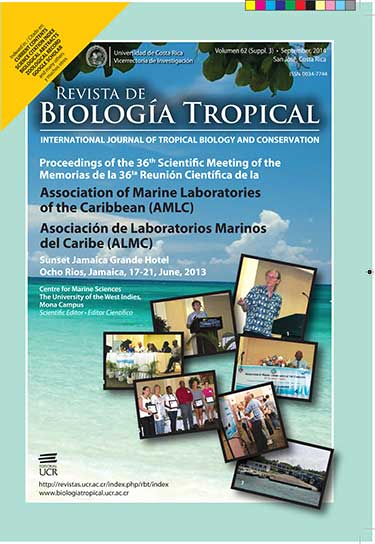Abstract
The coral reefs located off the north coast of the Jamaican mainland are some of the best and most studied reefs in the world. Coral reefs of Pedro Bank, Jamaica were assessed in March, 2012 as part of the KSLOF Global Reef Expedition using a modified Atlantic and Gulf Rapid Reef Assessment (AGRRA) protocol. The main objectives were to: 1) characterize the distribution, structure and health of coral reefs; and 2) evaluate the population status of commercially important reef fishes and invertebrates. This work was conducted to assist in characterizing coral reef habitats within and outside a proposed fishery reserve, and identify other possible conservation zones. Within 20 reefs, live coral cover ranged from 4.9% to 19.2%. Coral communities were dominated by small corals (esp. Agaricia, Porites and Siderastrea) although many sites had high abundances of large colonies of Montastraea annularis and M. faveolata, and these were generally in good condition. A single area, within the proposed fishery reserve, had extensive Acropora cervicornis thickets, and several shallow locations had small, but recovering A. palmata stands. Macroalgal cover at all sites was relatively low, with only three sites having greater than 30% cover; crustose coralline algae (CCA) was high, with eight sites exceeding 20% cover. Fish biomass at all sites near the Cays was low, with a dominance of herbivores (parrotfish and surgeonfish) and a near absence of groupers, snappers and other commercially important species. While parrotfish were the most abundant fish, these were all extremely small (mean size= 12cm; <4% over 29cm), and they were dominated by red band parrotfish (Sparisoma aurofrenatum) followed by striped parrotfish (Scarus iseri). While coral communities remain in better condition than most coastal reefs in Jamaica, intense fishing pressure using fish traps (main target species: surgeonfish) and hookah/spear fishing (main target: parrotfish) is of grave concern to the future persistence of these reefs. The proposed fishery reserve encompasses some of the best coral reef habitat near the Cays, but this MPA should be expanded to encompass other habitats and MPAs should be considered for bank reefs at the northwestern end, as well as Banner Reef and Blowers Rock. Rev. Biol. Trop. 62 (Suppl. 3): 11-24. Epub 2014 September 01.References
Aiken, K., & Kong, G. A. (2000). The marine fisheries of Jamaica. The ICLARM Quarterly, 23, 29-35.
Bohnsack, J. A. (1990). The potential of marine fishery reserves for reef fish management in the US Southern Atlantic. NOAA Tech. Memo NMFS-SEFC-261, Miami.
Bruckner, A.W. (2003). Proceedings of the Caribbean Acropora workshop: potential application of the
Endangered Species Act as a conservation strategy. NOAA Tech. Memo. NMFSOPR-24.
Bruckner, A. (2012a). Factors contributing to the regional decline of Montastraea annularis (complex). Proc. 12th Int. Coral Reef Symp., Cairns 11B_1, Phase shifts and alternative states on coral reefs.
Bruckner, A. (2012b). Static measures of the resilience of Caribbean coral populations. Revista de Biologia Tropical, 60(Supl. 1), 39-57.
Bruckner, A. W., & Hill, R. (2009). Ten years of change to coral communities off Mona and Desecheo Islands, Puerto Rico from disease and bleaching. Diseases of Aquatic Organisms, 87, 19-31.
Clarke, K., & Gorley, R. N. (2006). PRIMER v6 - User Manual/Tutorial. Plymouth: Primer-e Ltd.
Clarke, K., & Warwick, R. (2001). Changes in marine communities: an approach to statistical analysis and interpretation. Plymouth: Primer-e Ltd.
Espeut, P. (2006). The Wild Frontier: Living and fishing on the Pedro Cays of Jamaica: a Socio-economic Assessment. Kingston: The Nature Conservancy.
Gustavson, K. (2002). Economic production from the artisanal fisheries of Jamaica. Fisheries Research, 57, 103-115.
Hawkins, J. P., & Roberts, C. M. (2003). Effects of fishing on sex-changing Caribbean parrotfishes. Biological Conservation, 115, 213-216.
Hay, D. B. (2006). Biological survey of the Pedro Cays. Kingston: The Nature Conservancy
HRI. (2008). Healthy reefs for healthy people. A guide to indicators of reef health and social well-bieng in the Mesoamerican reef region. Retrieved from www.healthyreefs.org
Hughes, T. P. (1994). Catastrophes, phase shifts, and large scale degradation of a Caribbean coral reef. Science, 265, 1547-1551.
Koslow, J. A., Hanley, F., & Wicklund, R. (1988). Effects of fishing on reef fish communities at Pedro Bank and Port Royal Cays, Jamaica. Marine Ecology Progress Series, 43, 201-212.
Kramer, P. R. (2006). Pedro Bank Coral Reefs: Status of coral reef and reef fishes. Report for the Nature Conservancy. Miami, FL: The Ocean Research and Education Foundation.
Lang, J. L. (2003). Status of coral reefs in the western Atlantic: results of initial surveys, Atlantic and Gulf Rapid Reef Assessment (AGGRA) program. Atoll Research Bulletin, 496, 1- 630.
Miller, J., Atkinson, A., & Witcher, B. (2009). Coral disease following massive bleaching in 2005 causes 60% decline in coral cover on reefs in the US Virgin Islands. Coral Reefs, 28, 925-937.
Munro, J. L. (1983). Caribbean coral reef fishery resources. A second edition of ‘The Biology, ecology, exploitation and management of Caribbean reef fishes: scientific report of the ODA/UWI Fisheries Ecology Research Project, 1969-1973’. University of the West Indies, Jamaica. ICLARM Studies Review, 7, 1-276.
Nicholson, W., & Hartsuijker, L. (1982). The State of the Fisheries Resources of the Pedro Bank and South Jamaica Shelf. FAO Fisheries Report, 278, 215-254.
Pauly, D. (1979). Theory and management of tropical multispecies stocks: a review with emphasis on the Southeast Asian demersal fisheries. ICLARM Studies Review, 1,1-35.
Pauly, D. (1990). On Malthusian overfishing. Naga. ICLARM Quarterly, 13(1), 3-4.
Szmant, A. M. (1991). Sexual reproduction by the Caribbean reef corals Montastraea annularis and M. cavernosa. Marine Ecology Progress Series, 74,13-25.
Szmant-Froelich, A. M. (1985). The effect of colony size on the reproductive ability of the Caribbean coral Montastraea annularis (Ellis and Solander). Proc. 5th Int. Coral Reef Symp., Tahiti, 4, 295-300.
Zenny, N. (2006). Technical Summary of the Jamaica Ecoregional Planning (JERP), Marine Analysis. Draft. Kingston: The Nature Conservancy Jamaica Country Programme.
##plugins.facebook.comentarios##

This work is licensed under a Creative Commons Attribution 4.0 International License.
Copyright (c) 2014 Revista de Biología Tropical


